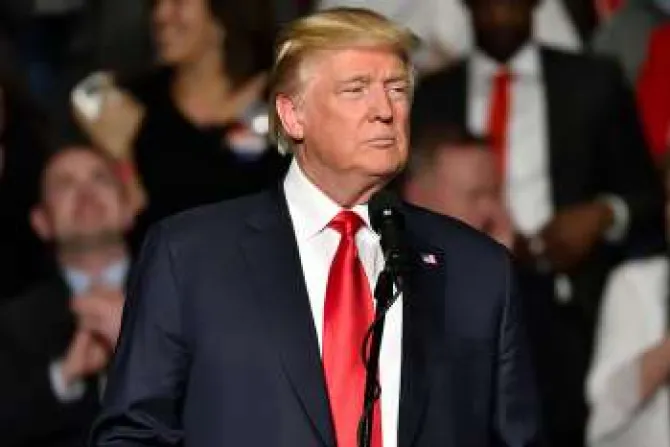Washington D.C., Nov 8, 2018 / 15:36 pm
Following the 2018 mid-term elections, U.S. President Donald Trump said in a Nov. 7 press conference that he alone has a plan for making pro-life progress, now that Democrats have taken control of the House of Representatives.
Asked by EWTN News Nightly how he would continue pushing forward the pro-life agenda with a now-divided Congress, Trump responded, "I won't be able to explain that to you, because it is an issue that is a very divisive, polarizing issue. But there is a solution. I think I have that solution, and nobody else does. We're going to be working on that."
The president declined to give details. He applauded his efforts so far, saying, "I've done a very good job. They're very happy with me."
Now halfway through his presidential term, what exactly has Trump done for the pro-life movement so far, and what remains to be done?
In his first two years as president, Trump has enacted several pro-life policies, focused largely on reversing Obama-era measures to expand abortion funding.
Within days of taking office, he reinstated and expanded the Mexico City Policy, ensuring that U.S. tax dollars are not funding the provision or promotion of abortion overseas in any U.S. global health spending. His administration has defunded UNFPA on the grounds that it supports coercive abortion and sterilization in China, and has repealed Obama-era guidance preventing states from defunding abortion facilities of Medicaid dollars.
Trump's Department of Health and Human Services has issued new rules that require health insurers to specify whether plans cover abortions and has proposed a rule to cut Title X taxpayer funding from any facility that performs or refers for abortions. The department has also announced the creation of a Conscience and Religious Freedom Division, which will work to protect medical professionals who object to cooperating with abortion.
And Trump has appointed two pro-life justices to the Supreme Court, and dozens more to lower courts throughout the country.
With these steps already taken in the first half of Trump's term, many of the key political goals remaining for the pro-life movement are dependent upon other branches of government.
Ending the federal funding of Planned Parenthood, a major pro-life objective, would require the cooperation of a now-divided Congress. Overturning Roe v. Wade would fall to the Supreme Court. Restrictions on abortion – such as 20-week limits, ultrasound requirements, and bans on abortions based on genetic abnormality – are largely enacted at the state level. If Roe v. Wade were to be overturned, it would also be up to individual states to prohibit abortion.
At this point, Trump has exhausted much of his power as president. What remains for him to push a pro-life "solution"?
One possibility for sidestepping Congressional gridlock and advancing pro-life legislation is to offer some other issue as a compromise. Given the Democratic Party's emphasis in recent years on abortion as a non-negotiable value, it could be difficult to find any other issue that would incentivize them to cede any ground in this realm.
Immigration and health care are both major issues of concern for the Democrats. But since a tough immigration stance has been among Trump's chief talking points from day one, it seems unlikely that he would be willing to use it as a bargaining chip. It's possible that he could attempt a deal that would create a new health care plan both maintaining key elements of the current law and including pro-life protections, but finding a proposal that would satisfy both Democrats and Republicans seems improbable.
A more realistic area of focus for the pro-life movement is the Supreme Court. Two justices on the court are in their 80s. It is likely that Trump will have the opportunity to appoint at least one – if not two – more justices, and with the Senate still in the hands of the GOP, the appointments will probably be confirmed. Trump has so far lived up to his campaign promise of appointing pro-life justices, and another addition or two to the nation's highest court would create a solid pro-life majority.
Of course, relying on the Supreme Court is a waiting game. It would be a matter of waiting for the right case to come up from a lower court – not just any case involving abortion, but one in which the legal technicalities all allow for a clear and decisive ruling in favor of the unborn. The effects of Supreme Court shake-ups are often felt only years, or decades, later.
But ultimately, Trump's appointments to the Supreme Court may prove to be his most enduring contribution to the pro-life movement. Executive orders can easily be – and in fact, generally are – overturned by a future president upon taking office. Laws can be repealed by a future Congress. But Supreme Court justices serve lifetime appointments, and their rulings routinely go decades before being reconsidered, if they ever are. A single Supreme Court ruling against the legality of abortion could shape the U.S. landscape for generations to come, by passing the decision from the federal government, to the states.
(Story continues below)
Since Trump did not give details about his plan to fight abortion, it is uncertain what that plan actually entails. But given the limits of his own power, such a solution would realistically require either an extraordinary feat of cooperation in Congress, or a long-term battle in the nation's high court. Whether either approach is Trump's promised "solution" – and whether it proves successful – remains to be seen.


